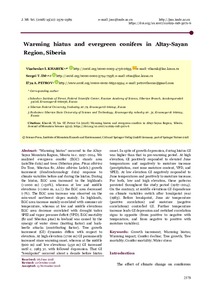Показать сокращенную информацию
Warming hiatus and evergreen conifers in Altay-Sayan Region, Siberia
| Автор | Viacheslav I. Kharuk | |
| Автор | Sergei T. Im | |
| Автор | Il’ya A. Petrov | |
| Дата внесения | 2020-01-20T07:12:17Z | |
| Дата, когда ресурс стал доступен | 2020-01-20T07:12:17Z | |
| Дата публикации | 2018-12 | |
| Библиографическое описание | Viacheslav I. Kharuk. Warming hiatus and evergreen conifers in Altay-Sayan Region, Siberia [Текст] / Viacheslav I. Kharuk, Sergei T. Im, Il’ya A. Petrov // Journal of Mountain Science. — 2018. — Т. 15 (№ 12). — С. 2579-2589 | |
| ISSN | 16726316 | |
| URI (для ссылок/цитирований) | https://link.springer.com/article/10.1007/s11629-018-5071-6 | |
| URI (для ссылок/цитирований) | https://elib.sfu-kras.ru/handle/2311/128474 | |
| Описание | Текст статьи не публикуется в открытом доступе в соответствии с политикой журнала. | |
| Аннотация | “Warming hiatus” occurred in the Altay-Sayan Mountain Region, Siberia in c. 1997–2014. We analyzed evergreen conifer (EGC) stands area (satellite data) and trees (Siberian pine, Pinus sibirica Du Tour, Siberian fir, Abies sibirica Ledeb.) growth increment (dendrochronology data) response to climate variables before and during the hiatus. During the hiatus, EGC area increased in the highlands (>1000 m) (+30%), whereas at low and middle elevations (<1000 m. a.s.l.) the EGC area decreased (-7%). The EGC area increase was observed on the rain-ward northwest slopes mainly. In highlands, EGC area increase mainly correlated with summer air temperature, whereas at low and middle elevations EGC area decrease correlated with drought index SPEI and vapor pressure deficit (VPD). EGC mortality (fir and Siberian pine) in lowland was caused by the synergy of water stress (inciting factor) and barkbeetle attacks (contributing factor). Tree growth increment (GI) dynamics differs with respect to elevation. At high elevation (1700 m) GI permanently increased since warming onset, whereas at the middle (900 m) and low elevations (450 m) GI increased until c. 1983 yr. with followed depression. That GI “breakpoint” occurred about a decade before hiatus onset. In spite of growth depression, during hiatus GI was higher than that in pre-warming period. At high elevation, GI positively responded to elevated June temperatures and negatively to moisture increase (precipitation, root zone moisture content, VPD, and SPEI). At low elevation GI negatively responded to June temperatures and positively to moisture increase. For both, low and high elevation, these patterns persisted throughout the study period (1967–2014). On the contrary, at middle elevations GI dependence on climate variables switch after breakpoint year (1983). Before breakpoint, June air temperature (positive correlation) and moisture (negative correlations) controlled GI. Further temperature increase leads GI depression and switched correlation signs to opposite (from positive to negative with temperature, and from negative to positive with moisture variables). | |
| Тема | Growth increment | |
| Тема | Warming hiatus | |
| Тема | Warming impact | |
| Тема | Conifer decline | |
| Тема | Tree growth | |
| Тема | Tree mortality | |
| Тема | Conifer mortality | |
| Тема | Water stress | |
| Название | Warming hiatus and evergreen conifers in Altay-Sayan Region, Siberia | |
| Тип | Journal Article | |
| Тип | Published Journal Article | |
| Страницы | 2579-2589 | |
| ГРНТИ | 34.35 | |
| Дата обновления | 2020-01-20T07:12:17Z | |
| DOI | 10.1007/s11629-018-5071-6 | |
| Институт | Институт космических и информационных технологий | |
| Институт | Институт экологии и географии | |
| Подразделение | Базовая кафедра геоинформационных систем | |
| Подразделение | Кафедра географии | |
| Журнал | Journal of Mountain Science | |
| Квартиль журнала в Scopus | Q2 | |
| Квартиль журнала в Web of Science | Q4 |

